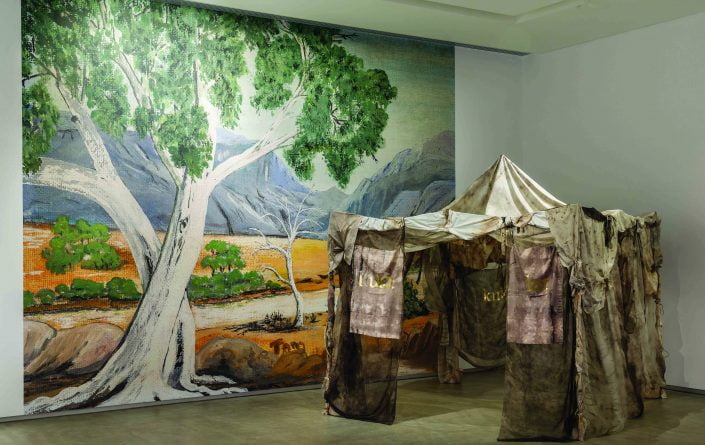Paola Balla
Wemba Wemba & Gunditijmara
Born 1974, Narrm/Melbourne
Lives and works in Narrm/Melbourne
Dr Paola Balla is a Wemba-Wemba & Gunditjmara artist, curator, writer & academic who focuses on Aboriginal women’s resistance, art & stories. Her work is published in Freize (UK), Oceania, Etchings Indigenous, Writers Victoria, SBS, NITV, Metro Magazine & Cordite Poetry. In 2018, she co-edited Blak Brow, Blak women’s edition, The Lifted Brow & in 2021 co-edited Artlink Indigenous; Visualising Sovereignty with Dr Ali Gumillya Baker. Paola co-curated Sovereignty (2016) & Unfinished Business, perspectives on art and feminism, (2017) ACCA. Most recently her art was shown in Wilam Biik, (2021), Tarra Warra Museum of Art, Treaty, (2021) Wyndham Arts & Cultural Centre, Sovereign Sisters; Domestic Work, FUMA (2022) . She is a researcher & teaches Indigenous Education & Indigenous Art at Moondani Balluk, Indigenous Academic Centre, Victoria University. Balla’s art addresses the impacts of racism and trauma on Aboriginal women and celebrates Blak beauty, story and resistance in photography and installation.
In WILAM BIIK; Murrup (Ghost) Weaving in Rosie Kuka Lar (Grandmother’s Camp), 2021, is an intergenerational temporal place of ‘knowing, being and doing,’ (as named by Prof Karen Martin) within Wurundjeri Country, between grandmother and granddaughter, and is a place to contemplate healing in the unconditional love of Country as a living entity. The term Ghost Weaving was developed with Professor Tracey Bunda, Ngugi/Wakka Wakka scholar, to name a matrilineal, intergenerational research method.
I created this space to visualise healing from ongoing traumas, racism
and the impacts of grief created by colonisation, to show what healing
spaces could feel like, where restorative aesthetics, cultural acts and
sovereign art weave across time. However, the capacity to express
sovereignty does not erase trauma. Healing is not forgetting. Healing
is not always forgiveness.
The painting that holds this space appears twice, once as an original
painting, and once as a memory scape of Country recreated in a
wallpaper. The artist is my late grandmother, Rosie Tang, nee Egan,
(1929–1993) a Wemba-Wemba & Gunditjmara woman, mother,
grandmother, Aunty, sister, artist and poet. I am honoured to share
her painting as a generational, matriarchal way of knowing Country.
Her painting was gifted to me by a family friend, Mrs Carol Higgs nee
Duffy, who sent the painting from Toowoomba, Queensland back to me
in Footscray, Victoria, during one of the COVID–19 lockdowns in 2020.
Having bought the painting from my grandmother around 1978, Carol
got in touch with me via Facebook because she wanted me to now have
the painting. Sadly, just weeks later, Carol passed away. Loving thanks
to Carol for this beautiful gift. My grandmother taught me how to ‘see’
Country by drawing and painting it. This work is a tribute to her, her art,
and her love for family and community, and functions as a place of
remembrance.
Bush dyeing and creating spaces of healing are methods of both cultural
and artistic practice; of deep listening to the women and family who walk
with me, and of deep listening to Country and Ancestors.
Bush dyeing is a slow lesson about the healing process; it is supported
by collective knowledge and processes, but is also intimately personal,
even though the context and historical traumas that cause the wounds
are political. Some marks appear as animal, spirit, or both; different
people see different things and share their ways of seeing with me.
It’s like looking for spirit faces in gum trees along Dungala, Campaspe
and Kolety Rivers, the way my grandmother taught me.
– Artist Statement
Artworks — Exhibitions
-

Paola Balla Rosie Tang Untitled c. 1978
Untitled c. 1978 oil painting on canvas 18.5 x 23.5 cm Courtesy of Paola Balla
-

Paola Balla Murrup (Ghost) Weaving in Rosie Kuka Lar (Grandmother’s Camp) and Rosie Tang 'Untitled Wallpaper' 2021
Installation view at TarraWarra Museum of Art. Photograph: Andrew CurtisUntitled Wallpaper 2021 Phototex wallpaper, printed by Colour Factory 350x433cm Courtesy of Paola Balla
-

Paola Balla Murrup (Ghost) Weaving in Rosie Kuka Lar (Grandmother’s Camp) - detail 2021
bush dyed silk organza, rope, string, calico, with eucalyptus, lilly pilly, tea tree, flowering gum, bottle brush, native lilac, rust, mould, gold foil screen print, gazebo frame. 300 x 300 x 300 cm. Courtesy of the artist. Screen print in collaboration with Space Craft Studios





